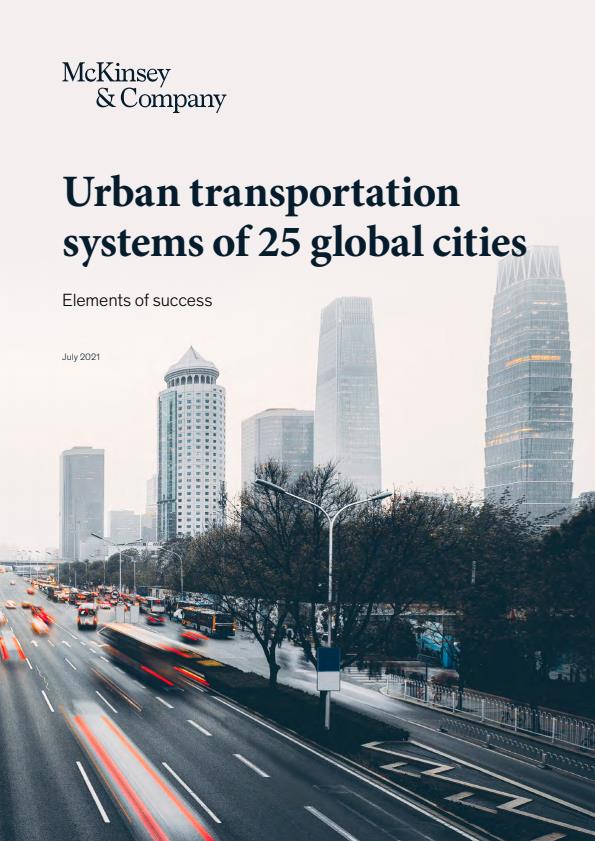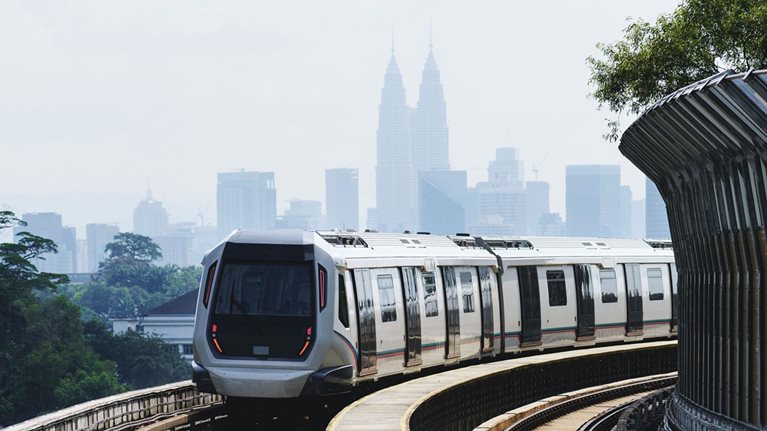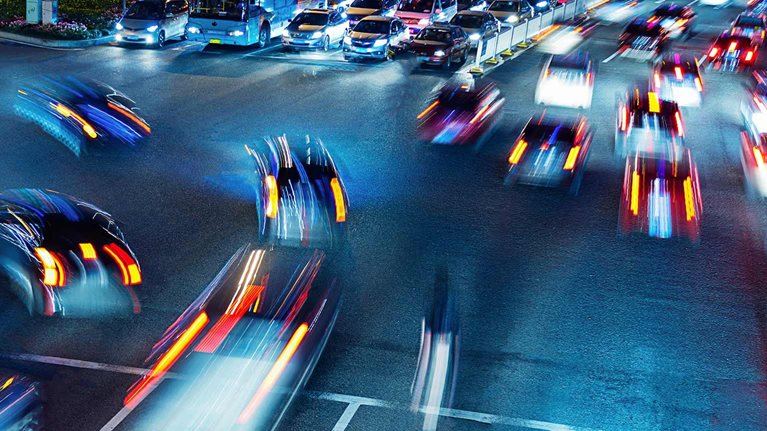A city’s transportation network is its cardiovascular system—a multifaceted structure that enables the continuous flow of people and goods through its arteries. Municipal authorities, city councils, urban planners, and transport-infrastructure owners and operators around the world are well aware that its quality and efficiency are crucial for the economy and for the well-being of citizens.
To help stakeholders make informed decisions, we benchmarked the transport systems in 25 cities around the world in our latest report, Key elements of success in urban transportation systems (see sidebar “The research methodology”). We ranked the cities and grouped them into three categories: leading (first through tenth place), contending (11th through 18th), and emerging (19th through 25th).
All 25 cities have expanded projects to enhance their transport systems since 2018 (Exhibit 1). Leading cities invested more in improving the availability of their public-transport infrastructure, while emerging cities invested relatively less in safety and sustainability than in the other categories. As this article explains, such factors could have implications on residents’ willingness to use public transport.

While decision makers should delve into the full report for the complete rankings and details (see sidebar “Rankings at a glance: Top five cities by category”), this article distills the report’s findings into five key insights that stakeholders should pay attention to and highlights best-in-class practices in cities around the world.
1. Keeping service and safety standards high assuages pandemic-related fears of using public transport
COVID-19 lockdown restrictions clearly had an impact on lifestyles and commuting patterns in 2020. Many people stopped traveling to work completely. People who relied on private cars, as well as those who used public transport, actually increased their use of private cars, even as the overall number of trips dipped (Exhibit 2). And in some cities, staff shortages and declining revenue from lower passenger usage led to reductions in service frequencies to avoid fare increases.

If these trends persist postpandemic, they are likely to exacerbate traffic congestion, pollution, and the number of traffic accidents. As such, public-transport operators and authorities will need to find ways to restore confidence in shared modes of getting around and reduce reliance on private cars. Our research found that the safer people feel about using public transport, the more they’ll use it (Exhibit 3), which suggests that the visibility of pandemic-related safety measures has a significant influence on perceived risks.

In Chinese cities, there is a lower perceived risk of infection on public-transport systems, thanks to a mandatory mask mandate, physical-distancing mandate, regular disinfection, and other epidemiological safety measures that citizens visibly adhere to. These measures are stepped up as needed (for instance, when sporadic outbreaks occur), and commuters may have to present a green health code and have their temperatures taken before entering public-transport areas. As a result, Chinese cities also experienced higher-than-average levels of public-transport mobility during the pandemic.
2. Expanding transport networks and infrastructure, as well as smart policies, keep travel options available and affordable
The top-scoring cities in transport availability—London, Madrid, and Paris—share some common characteristics: they are major railway hubs and offer good road networks, bike lanes, and pedestrian infrastructure. Beijing, Madrid, and Moscow jumped up in the transport-availability rankings by expanding their metro and rail lines. These cities also improved their road infrastructure, increased the number of bicycle lanes and pedestrian streets, and invested heavily in shared-transport schemes such as rental-bike and ride-sharing services (Exhibit 4).

Madrid’s bike-share system consists of 3,000 bicycles and 250 rental stations, with 50 rental stations added in 2020 alone. Since our last urban-transport report, in 2018, Moscow added 3,000 two-wheelers to its bike-share program. It also opened new underground lines, resulting in 700,000 more people gaining access to the Moscow Metro, while Beijing opened three new underground lines over the past several years.
Public policies play a critical role in keeping transport affordable, whether it’s by regulating low bus and subway fares or by encouraging competition between legacy transport operators and ride-sharing companies. High rates of private-car ownership tend to constrict revenue flows for the public-transport system because fewer people use public transport. Thus, policies that discourage private-car ownership tend to prevent public-transport operators from either raising fares or reducing service standards.
The Asian cities of Seoul, Shenzhen, and Singapore, for example, top the rankings for public-transport affordability, and to offset the environmental and societal costs of personal car use, these cities actively make car ownership a more expensive choice.
Public-transport systems in Buenos Aires, Mexico City, and Shanghai are also becoming much more affordable because of government policies stimulating economic competition and technology. Cars registered outside Shanghai are barred from certain districts, and technologies for self-driving taxis are being piloted, which may lead to lower costs in the future. Commuters enjoy the benefit of lower fares, the result of competition among multiple ride-share providers. The widespread implementation of paid parking systems in Buenos Aires and Mexico City is making private-car ownership more expensive. With more people turning to public transport or ride-sharing over private cars to avoid incurring parking costs, there are fewer vehicles on the road, which eases traffic congestion.
3. Dedicated public-transport lanes and digitalization can make the commuter experience more efficient and convenient
Efficiency refers to how quickly and predictably one can move around the city, while convenience measures how easily commuters can switch from one mode of transport to another. Increasing the number of dedicated public-transport lanes, optimizing bus routes, completing road construction or modernization projects, and implementing digital upgrades all help improve the commuter experience.
Moscow, Shenzhen, and Singapore all scored high on transport efficiency. The Russian capital’s transport system has low underground waiting times, high speeds during rush hour, and a significantly above-average proportion of dedicated bus lanes. Shenzhen, too, has a high share of dedicated bus lanes, which helps with rush-hour predictability. Singapore’s electronic road-pricing system is powered by a digital device that automatically charges the driver the road toll when the car passes through a gantry, enabling frictionless road travel for both private and public vehicles, even during peak times.
Our convenience index assesses the ease of switching from one transport mode to another. High performers have invested in upgrading their ticketing systems, increasing internet access, and increasing the number of wheelchair-accessible buses and underground stations. Some offer convenient mobility-as-a-service applications (MaaS) to plan routes and to verify and pay fines and penalties.
Toronto delivers high levels of travel comfort, courtesy of a $934 million upgrade of its bus fleet, which is now 100 percent wheelchair friendly and located closer to subway stations. Hong Kong has also revamped its public-transport system. Ninety out of 93 metro stations have been outfitted with elevators and wheelchair ramps, making it easier and quicker for wheelchair-bound passengers to board and disembark. Meanwhile, Istanbul has risen in the convenience rankings with a significantly improved ticketing system using QR-code payments. The city has also introduced the Ulasim Asistani app, which helps travelers plan journeys across multiple forms of transport, leading to a considerable improvement in satisfaction ratings among its citizens.
4. Sustainability matters—in both investment and policy
Both commuter safety and the environment cannot be neglected in a city’s efforts to improve its transport system. In both our 2018 and 2021 surveys, respondents cited safety as their number-one priority, so it’s imperative that city planners and authorities constantly look to minimize accidents and fatalities while reducing the city’s carbon footprint. As mentioned earlier, leading cities tend to invest more in sustainable mobility options than contending and emerging cities do, which has resulted in greater use of their public-transport systems (Exhibit 5).

Initiatives to ensure compliance with safety requirements matter, as do the implementation of more stringent restrictions on the use of petrol and diesel engines, measures to reduce pollution, and incentives to switch to electric vehicles.
Tokyo boasts one of the world’s lowest road-fatality levels—9.6 deaths per 1 million people. Over the past several years, the government has deployed the data-driven smart-transport system to monitor and analyze information on people’s commuting patterns and traffic violations to inform decision making. As a result, road fatalities have decreased and more people are complying with traffic rules. The government is also using new toll-management technology to decrease vehicle traffic and improve road safety.
In China, Beijing and Shanghai are aggressively curbing the negative environmental impact of their transport systems. Both cities mandated in 2021 that only vehicles that adhere to the China 6 emissions standards (roughly equivalent to the Euro 6 standard in the European Union) can be sold.
5. In some cases, better communication is needed to bridge gaps between perception and reality
We tracked how satisfied residents were with how their transport system is doing according to specific metrics and based on changes implemented since 2018. Residents appear to appreciate the hard work urban authorities have put into transport projects, but in a few cases, their perceptions may not be aligned with reality. For instance, most citizens feel that public transport is too expensive in their cities (Exhibit 6). So even though Seoul, for example, stands out as a leader in public-transport affordability based on objective metrics, its citizens remain dissatisfied.

This suggests that authorities need to keep the residents informed of all positive changes and continue their efforts to improve public perceptions. It is highly likely that additional restrictions on personal motor vehicles will be introduced in the coming years and that environmental regulations will become more stringent. To improve the public perception of such efforts, city authorities must not only score tangible successes but also clearly articulate them.
Our full progress report benchmarking the transport systems in 25 cities around the world investigates the five themes outlined in this article in greater depth, and includes other findings that are relevant to key stakeholders. Overall, while there’s reason to celebrate the many improvements in the majority of our metrics in cities around the world, there’s still much work to be done. Making informed decisions about the further development of city transport systems will help.



